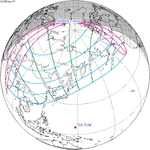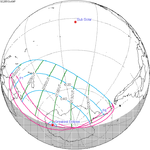Solar eclipse of September 22, 2052
| Solar eclipse of September 22, 2052 | |
|---|---|
| Type of eclipse | |
| Nature | Annular |
| Gamma | −0.448 |
| Magnitude | 0.9734 |
| Maximum eclipse | |
| Duration | 171 s (2 min 51 s) |
| Coordinates | 25°42′S 175°00′E / 25.7°S 175°E |
| Max. width of band | 106 km (66 mi) |
| Times (UTC) | |
| Greatest eclipse | 23:39:10 |
| References | |
| Saros | 135 (41 of 71) |
| Catalog # (SE5000) | 9624 |
An annular solar eclipse will occur on September 22, 2052. A solar eclipse occurs when the Moon passes between Earth and the Sun, thereby totally or partly obscuring the image of the Sun for a viewer on Earth. An annular solar eclipse occurs when the Moon's apparent diameter is smaller than the Sun's, blocking most of the Sun's light and causing the Sun to look like an annulus (ring). An annular eclipse appears as a partial eclipse over a region of the Earth thousands of kilometres wide.
Related eclipses
Solar eclipses 2051-2054
This eclipse is a member of a semester series. An eclipse in a semester series of solar eclipses repeats approximately every 177 days and 4 hours (a semester) at alternating nodes of the Moon's orbit.[1]
The partial solar eclipse on August 3, 2054 occurs in the next lunar year eclipse set.
| Solar eclipse series sets from 2051 to 2054 | ||||||
|---|---|---|---|---|---|---|
| Descending node | Ascending node | |||||
| Saros | Map | Gamma | Saros | Map | Gamma | |
| 120 | April 11, 2051 Partial |
1.0169 | 125 | October 4, 2051 Partial |
−1.2094 | |
| 130 | March 30, 2052 Total |
0.3238 | 135 | September 22, 2052 Annular |
−0.448 | |
| 140 | March 20, 2053 Annular |
−0.4089 | 145 | September 12, 2053 Total |
0.314 | |
| 150 | March 9, 2054 Partial |
−1.1711 | 155 | September 2, 2054 Partial |
1.0215 | |
References
- ^ van Gent, R.H. "Solar- and Lunar-Eclipse Predictions from Antiquity to the Present". A Catalogue of Eclipse Cycles. Utrecht University. Retrieved 6 October 2018.
External links




